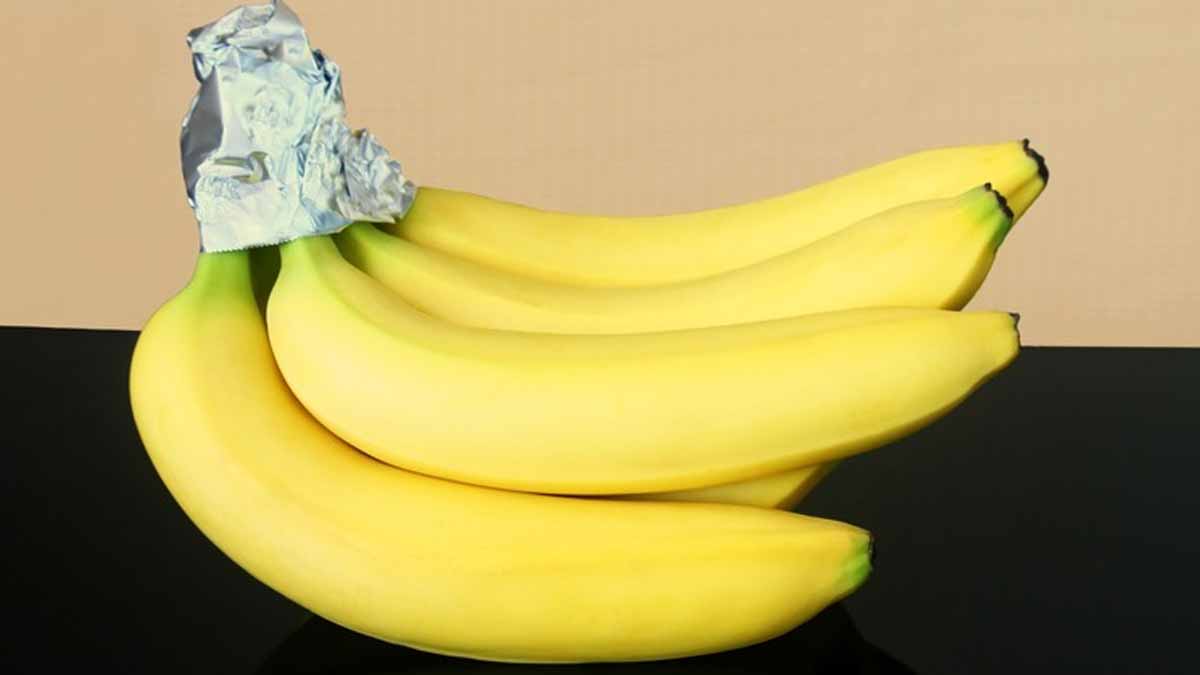A small change in storage keeps bananas bright, sweet, and ready when you are. The trick works because ripening relies on a natural gas that moves fast between fruits, so one mistake speeds browning. Use one everyday item at the right spot, and the clock slows. Then texture stays firm, color holds, and waste drops without effort. Keep the mystery of the method for a moment; the steps are simple, quick, and easy to repeat at home.
Ethylene, the invisible switch behind rapid ripening
Ethylene is a plant hormone that signals fruit to soften, sweeten, and change color. The message spreads through the air, and the more gas in a small space, the quicker the change. Apples and peaches release a lot, which matters because mixed bowls concentrate that signal around sensitive fruit.
As gas builds, the process snowballs, and a gentle ripening turns into a rush toward mush. The classic fruit bowl becomes a small chamber where aromas, warmth, and airflow combine, so skin freckles early and texture goes soft. A simple move to open air reduces that concentration and buys time.
Keep mixed produce apart because the chain reaction moves both ways. One ripe piece speeds the rest, while a firm one catches up faster than you think. Separate the bunch from apples and peaches on a counter with room to breathe. That way, bananas keep their moment of perfect bite longer.
Why bananas and the fruit bowl don’t get along
A compact bowl traps gas near the stems, where release is strongest. The curve of the bowl also limits airflow, so warmth lingers and moisture collects. That pairing accelerates browning, and spots appear while you plan breakfast. The fix starts by giving the bunch its own space away from other produce.
Set the fruit on the kitchen worktop, not pressed against walls or piled high. A few centimeters of air around each side helps gas drift away rather than pool. Because movement stays gentle at room temperature, color shifts evenly, and the sweet smell arrives on schedule without the sudden slide to soft.
Distance matters even more next to apples and peaches, which push the signal hard. Keep them in the bowl, and place the yellow fruit nearby on an open surface. Add a small gap from heat sources as well, and the difference shows within days. With separation, bananas hold shape and taste better.
Simple placement, big gains in day-to-day freshness
Location does the quiet work while you cook. Heat near an oven or air fryer speeds every reaction in the skin, so pigments darken faster, and enzymes race. Because warmth stacks with trapped gas, the combination doubles trouble. A cooler, steady spot on a counter keeps change slow, even while meals sizzle.
Light taps and tight corners bruise, which later turn brown patches into soft spots. Set the bunch where elbows won’t bump it and where bowls won’t press it. While airflow helps gas drift, gentle handling protects texture. With this small care routine in place, bananas look good and taste sweet for longer.
Room temperature supports a balanced pace, so flavor develops while firmness lasts. A wire stand or clean plate is fine; what matters is space around the stems. Because the stems drive gas release, the area above them should not be boxed in. Good placement keeps color yellow and peel smooth.
Wrap that works: locking freshness at the source for bananas
A simple wrap around the stem slows ripening because it blocks the main exit for gas. According to Mandy Applegate of Two City Vegans, covering the stem area traps ethylene at its source, so less reaches the rest of the bunch. The effect stacks with separation and airflow, extending peak texture.
Plastic wrap or cling film works well, and foil is a valid stand-in when that’s handy. Use a small piece snugly around the crown to limit leaks without sealing the whole fruit. Because the pulp needs air, leave the bodies uncovered. That way the skin breathes while the signal stays contained near the top.
With the stems wrapped, room-temperature storage performs even better. Mandy notes the fruit stays firm and yellow noticeably longer with just this quick step. Because the technique takes seconds, it fits busy mornings easily. Keep the wrap in a drawer, apply after shopping, and bananas reward you with extra fresh days.
Numbers that matter: how long this method really buys
The results show up on the calendar as well as the counter. Kept apart from other fruit, away from heat, and with stems wrapped, shelf life stretches a lot. According to the guidance shared, the bunch can remain fresh up to 10 days longer, sometimes even 14, which equals two full weeks of breakfasts.
That gain depends on consistent habits. Because gas moves faster in warm, crowded spots, a tidy setup protects every piece in the bunch. Check the crown once in a while, and smooth the wrap if it loosens. Since the wrap is small, the solution stays low-waste while the benefit stacks day after day.
Color and aroma guide timing. Skin speckles signal sweetness, yet firm feel means you still have margin. When one piece ripens quicker, place it in front for today’s snack while the rest continue under the same setup. That way, bananas ripen in a calm rhythm, not a stressful sprint toward waste.
Keep that perfect yellow a little longer without extra effort
Freshness sticks when simple rules shape your counter: separate from gas-heavy fruit, steer clear of heat, and wrap the stems. Because the gas slows at its source, color holds, and days stack up. A tiny piece of film changes the pace while life carries on. With this routine, bananas reward you with steady sweetness.
